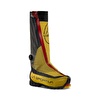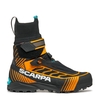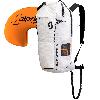Interview with Colin Haley and Alex Honnold after the Cerro Torre Traverse in day (Patagonia)

 1 / 3
1 / 3 Colin Haley, Alex Honnold
Colin Haley, Alex Honnold
Yet another great ascent in a Patagonia that apparently knows no limits: on Sunday 31 January 2016 the American alpinists Colin Haley and Alex Honnold carried out the first repeat of the famous Torre Traverse in a single day, reaching the summits of Cerro Standhardt, Punta Herron, Torre Egger and Cerro Torre in a mere 20 hours and 40 minutes. In total the two needed 32 hours to descend to their tent pitched on the glacier, and 44 hours to make their way back to El Chalten. According to the Americans, at first the climb "almost felt too easy": starting at 3:20 am from Col Standhardt, they needed 4:09 to reach the summit of Standhardt, 3:11 to stand on the summit of Punta Herron and a further 2:07 to the top of Torre Egger. Bad conditions on Cerro Torre slowed them down but nevertheless the summited at midnight before making their way - slowly but surely - down the SE Ridge back to their tent.
The great Tore Traverse was long considered one of the most coveted projects in Patagonia, thought up over twenty years ago by the Italians Ermanno Salvaterra, Andrea Sarchi, Maurizio Giarolli and Elio Orlandi and climbed successfully over a period of four days in January 2008 by Rolando Garibotti and Colin Haley. In the meantime 29-year-old Haley has spent almost every austral summer in the mountains down "at the end of the world", establishing new lines and repeat existing routes, often alone, such as his first solo climb of Torre Egger and Punta Herron about a fortnight ago. In January 2015 Haley and Honnold attempted the traverse in a single day, but after climbing for 22 hours they were forced back two pitches below the summit of Cerro Torre due to the Patagonian gales. This year the duo made sure those amazing 2400m of climbing were theirs to keep.
20 hours and 40 minutes from Col Standhardt to Cerro Torre summit. Did you ever imagine you’d be this fast?
Alex: We did know that it would be around that time. When we attempted the traverse last year it was somewhere in the same neighborhood, before we got stormed off Cerro Torre. And Colin has been spending so much time in the Torres that he knows everything super well.
So were you ever "slow"
Alex: The descent was pretty slow and careful. And the North Face of Cerro Torre was relatively slow, just because conditions were challenging and the climbing is harder.
Presumably Colin you know the entire route almost every inch of the way?
Colin: This was my 8th time reaching the summit of Cerro Torre, and my first time this season. This was my 9th time summiting Cerro Standhardt, my 5th time for Punta Herron, and my 6th time for Torre Egger. I’ve dedicated a ton of my life to climbing on the Torres, and at this point I think I'm more familiar with this ridgeline than anyone else. That prior knowledge is of course extremely helpful for us to be able to cover this terrain quickly.
What about you Alex?
Alex: It was my first time up Cerro Torre, which is very exciting. Too bad we summited at midnight so the sightseeing options were limited. Actually I know a lot of the entire route really well now. Last year we traversed to Torre Egger in a day and then tried the complete traverse as well. So I've been across the whole middle section three times now.
What can you tell us about the descent. Any bivouacs? How long were you on the go in total?
Alex: Our camp to camp time was 32 hours. No bivouacs, just slow and careful on the way down.
Colin: I'll add that after returning to our tent after 32 hours on the go, we still had a long hike out to do and a bunch of organizing at Niponino, so it ended up being about 44 hours without sleep by the time we finally arrived in town.
The all-important question: "risk". From 1 - 10, how much do you feel you risked during this climb?
Alex: Ha ha not sure if I can quantify. I didn't feel like we were ever doing anything really crazy. The only time I was honestly worried about safety was up high on the north face of Cerro Torre. I was super wet because the whole wall was running water and I was a little worried about getting hypothermic and not being able to get dry again.
Can you give us a concrete example about your safety meter?
Alex: Well despite moving quickly the whole day we still double check everything and talk things through a lot, particularly on the rappels. Neither of us wants to die in the mountains...
Colin, compared to your first ascent 8 years ago, what has changed?
Colin: A lot has changed. Climate change has undeniably made the weather less hostile in Patagonia. There is still plenty of bad weather in general, and two seasons ago was in fact a pretty "bad" season until late in the season, but in the past 8 years good weather has been much less rare than before. As I've built experience I've grown more and more accustomed and comfortable to being high up in the mountains here. There has been a paradigm shift in the general Patagonian climbing community, such that routes that felt really "out there" only ten years ago now feel fairly pedestrian. More than anything else though, what has changed for me is that I've simply improved a lot as a climber since 2008, and I'm proud of that.
So how do you judge this ascent in comparison to other climbs?
Colin: It’s hard to judge an ascent against others, so I won't try too hard to figure it out exactly, but I'd say that our climb on Sunday is, like my recent solo of Torre Egger, certainly among my very best. And without any doubt it is the single most "radical" day of climbing that I've ever had -it is so cool to cover so much extreme terrain, of such different types, all in one day.
Alex, how similar or different is this to the Fitz Roy traverse you did with Tommy Caldwell in 2014?
Alex: It felt totally different. The Fitz traverse felt like an adventurous rock climbing camping trip - we didn't know anything about the terrain and would just climb until we got tired and then camp. The Torres reminded me a lot more of doing the speed record on the Nose up El Capitan in Yosemite - we knew the terrain well and established a good strategy. It was all about good execution and efficiency.
Fitz Roy, Cerro Torre, Yosemite, in all of these you’re names are right at the top of the lists... but are you also preparing for other horizons? Or are these your "playgrounds"?
Alex: I like my playgrounds... I'm sure I'll keep traveling to climb in more places, but Yosemite and Patagonia are surely the best in the world.
Colin mentioned climate change: what are your views on this Alex?
Alex: I've only been here 3 years but even I see the glaciers shrinking. It's kind of crazy. And the weather seems a lot better than what I read about in books. But I haven't been here a lot so I wouldn’t really know.
How does your climbing partnership work? How do you manage to combine your individual, "solitary nature" with that of a climbing partnership?
Alex: Well the biggest thing might be our complimentary skill set. Colin is amazing on snow and ice and in the mountains in general. He's basically the guide for the approach and all the rappels and any mixed terrain. I get to lead the rock.
Colin: Yes, definitely our skill sets are super complimentary. We have very different strengths, and swap leads according to the terrain, yet each of us is sufficiently skilled in the other's domain to not ever be holding the team back.
Alex: It's funny, I remember something Colin wrote when he did the first traverse with Rolando Garibotti 8 years ago - something to the effect that two Rolos would have done it much faster and two of him couldn't have done it at all. Our traverse is very much the same. Two Colin's probably would have been a bit faster, two of me wouldn't have made it to the start of the route... But together it's the best of both.
Colin: It’s probably true that in 2016 two Colins would've had a better chance of doing a single-push Torre Traverse than two Alexs. However, we definitely are faster as a team than two Colins would've been. Alex can lead the rock sections way faster than me - it's not that he actually moves that much faster, but he is so solid and confident on this difficulty of rock that he doesn't need to place as much protection as I would. That allows us to simul-climb much further distances, and that's where the real efficiency is.
Alex is definitely one of the most impressive climbers that I've ever teamed up with. Not only is he an extremely talented rock climber, but I'm amazed at how adaptable he is - how efficient he can be on terrain in which he has not very much experience at all. One of the things that has been really cool about our partnership thus far, is I think we've both been learning a lot of new techniques from each other. Learning and improving is always one of the most exciting aspects of climbing to me, so that is pretty fun.
Alex: on a more personal level we get along really well and have fun climbing together, so that's always nice too.
Colin: Yeah, we get along well, which is most important. Despite Alex’s insistence that he's only dabbling a bit in alpine climbing, I have a suspicion that there is more in his future.
Rolando Garibotti wrote that "this record will stand for a long time to come." Apart from what other will get up to in the future, how do you see your own future?
Colin: There is so much that one can talk about on this subject, but here’s just one little thing I've been thinking about: Climbing in single-push style (not stopping to sleep, and therefore not bringing any bivouac equipment) is so damn fun, simply because having a lighter backpack really makes the whole experience more enjoyable for me. In my personal future I imagine more climbs without bivouac gear that a few years ago I might not have considered attempting in that way.
Talking of which, what gear did you take?
Alex: We took a double set of ultralight cams, 7 light ice screws, 2 micro traxions, a lightweight jugging set up, a 60m 8.5 lead line, a 60m 6mm tag line, and a few random extra bits and pieces. But overall it was all super light. The majority of our weight came from food and water - we each had over 4 liters to start and a ton of food. Oh and we had new light boots, crampons, one set of good tools and one set of lighter tools.
For those getting into alpinism, what do you feel you can suggest? Also bearing in mind the risks you take.
Alex: I honestly think the risk stuff is maybe a bit overstated. Our day of climbing was a lot bigger than average, but everyone climbing this weekend in the Torres was taking on similar levels of risk. Just being in the mountains at all carries risk. We chose an objective that inspired us and then made every effort to do it safely. I think that’s the same process that everyone goes through in climbing.
What’s the greater meaning, the reason behind an ascent of this sort?
Alex: What's the meaning behind going to the mountains at all? We set a challenging goal for ourselves and managed to pull it off. That’s enough meaning for me.
Last question, just to be certain we judged it right… presumably this was your main objective for 2016?
Colin: Yes, this was our top priority for climbing together this season. However, we got the weather and conditions to pull it off only a week or so after Alex's arrival, and we now have more time, so we’ll almost certainly try some other stuff as well.
| Expo.Planetmountain | |
| La Sportiva | |
| Petzl | |
| The North Face | |
| www | |
| FB Patagonia Vertical | |
| FB Alex Honnold | |
| FB Colin Haley | |
| www.pataclimb.com | |
| www.alexhonnold.com | |
| www.colinhaley.com | |



 Copia link
Copia link























